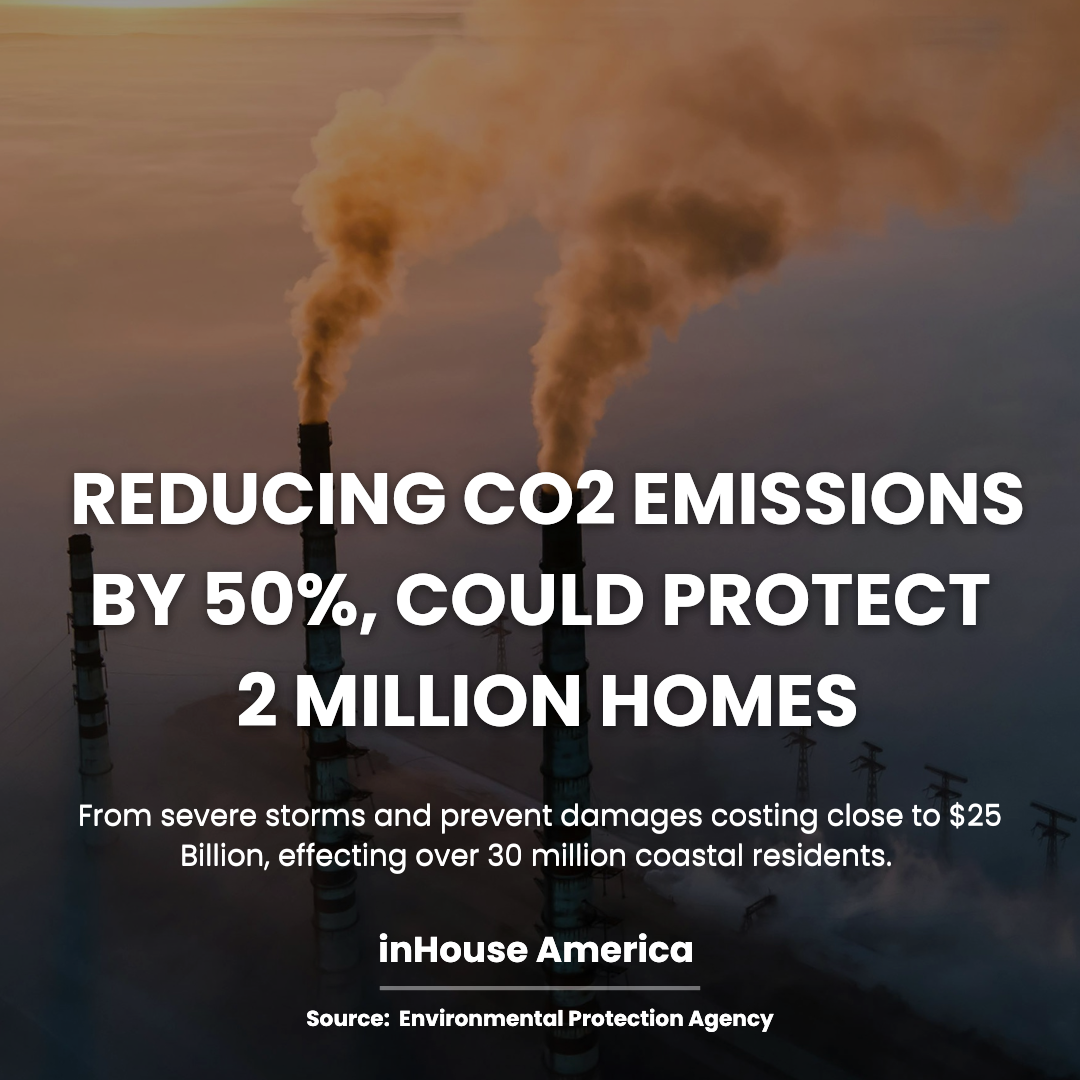InHouse America
Extreme Weather Affects 120 Million Americans from 2020-2024
Published: 8:30 pm (GMT-5), Mon September 9, 2024
3 Minute Read

Source: (Environmental Protection Agency (EPA))
Global Warming
(2020 - 2024)
Global temperatures increased by 0.9°F from 2020 to 2024, leading to more frequent heatwaves affecting 60 million Americans. Heat-related deaths rose by 20% to approximately 12,000 annually.
Solution: Achieving a 50% reduction in global CO₂ emissions by 2030 could mitigate an additional 1.5°F rise in temperatures, potentially reducing heatwave frequency by 25%.
Source: (International Energy Agency (IEA))
Insights: This could save 3,000 lives per year and reduce healthcare costs related to heat by $5 billion.
CO₂ Emissions
(2020 - 2024)
Atmospheric CO₂ levels rose from 414 ppm (Parts Per Million) in 2020 to 419 ppm (Parts Per Million) in 2024. This increase contributed to more severe storms, affecting 30 million coastal residents. Annual storm damages surged to $125 billion.
Solution: Transitioning to 50% renewable energy by 2024 could reduce CO₂ levels by 5 ppm, decreasing storm severity by 15%.
Source: (Environmental Protection Agency (EPA))
Insights: This transition could prevent $25 billion in damages and protect 2 million homes from severe flooding.
Ocean Warming
(2020 - 2024)
Ocean temperatures increased by 1.3°F, exacerbating the severity of hurricanes and displacing 5 million people. Annual damages from hurricanes reached $200 billion.
Solution: Investing $100 billion in ocean-based climate solutions, such as mangrove restoration, could reduce hurricane intensity by 20%.
Source: (National Climate Assessment)
Insights: This could save $40 billion annually in damages and protect 7 million people from severe weather impacts.
Deforestation
(2020 - 2024)
Annual deforestation of 1.2 million acres increased wildfire risk, impacting 40 million Americans. Wildfire damages reached $60 billion annually.
Solution: Reforesting 1 million acres per year could sequester 25 million metric tons of CO₂, reducing wildfire frequency by 15%.
Source: (U.S. Forest Service)
Insights: This action could save $25 billion in wildfire damages and improve air quality for 10 million people.
Methane Emissions
(2020 - 2024)
Methane emissions rose by 3% annually, contributing to 10% of extreme weather events. This affected 8 million Americans with increased health risks.
Solution: Implementing methane capture in 50% of U.S. livestock operations could cut methane emissions by 30%.
Source: (U.S. Environmental Protection Agency (EPA))
Insights: This could reduce severe weather incidents by 10% and lower health costs by $15 billion.
Hurricanes
(2020 - 2024)
Category 4 and 5 hurricanes increased by 25% from 2020 to 2024. Sea levels rose by 3 inches, affecting 8 million Americans and causing $125 billion in damages annually.
Solution: $100 billion in coastal defenses could reduce hurricane damage costs by 30%.
Source: (NOAA (National Oceanic and Atmospheric Administration))
Insights: This could save $35 billion annually and protect 12 million residents from severe flooding.
Wildfires
(2020 - 2024)
Annual wildfire acreage reached 10 million, affecting 20 million people.
Solution: Reforesting 1 million acres per year could reduce wildfire risk by 15%.
Source: (U.S. Forest Service)
Insights: This could save $25 billion in damages and benefit 10 million people by improving air quality.
Droughts
(2020 - 2024)
Severe droughts impacted 20% of the U.S. population. Agricultural losses reached $15 billion annually.
Solution: $10 billion investment in drought-resistant crops and water conservation could reduce agricultural losses by 20%.
Source: (U.S. Drought Monitor)
Insights: This could aid 10 million farmers and alleviate food price inflation.
Winter Storms
(2020 - 2024)
Severe winter storms affected 50 million Americans in 2024. Fatalities and power outages increased by 5%.
Solution: $5 billion in winter storm preparedness could reduce power outage impacts by 20%.
Source: (National Weather Service (NWS))
Insights: This could protect 10 million residents and save $2 billion annually in recovery costs.
Heatwaves
(2020 - 2024)
Heatwaves increased by 15%, affecting 60 million Americans.
Solution: $20 billion investment in heat-resilient infrastructure (e.g., cool roofs, urban green spaces) could reduce urban temperatures by 2-3°F.
Source: (Centers for Disease Control and Prevention (CDC))
Insights: This could mitigate health issues for 15 million people and save $10 billion in health costs.
Overview: U.S. Extreme Weather
(2020 - 2024)
From 2020 to 2024, extreme weather events impacted 120 million Americans, costing the U.S. $500 billion in damages. Hurricanes, wildfires, heatwaves, and floods worsened due to rising CO₂ levels, deforestation, and global warming.
Source: (NOAA (National Oceanic and Atmospheric Administration, EPA (Environmental Protection Agency) & U.S. Forest Service )
Insights: Solutions like cutting CO₂ emissions by 50%, investing $100 billion in coastal defenses, and reforesting 1 million acres annually could reduce these impacts by 30%, saving $150 billion and protecting 20 million people.
InHouse America Sustainability Vision
InHouse America aims to promote sustainability by supporting U.S. small businesses that adopt eco-friendly practices. Small businesses make up 99.9% of U.S. companies, and if 30% of them switched to sustainable methods, it could reduce U.S. carbon emissions by 15%, benefiting 100 million Americans.
Source: (Our Opinion)
Insights: By spotlighting these businesses, InHouse America seeks to drive a 20% increase in consumer demand for green products, accelerating the transition to a more sustainable economy.
InHouse America doesn't endorse anyone but focuses on creating awareness of the importance of supporting small businesses and which administration is best for doing so!